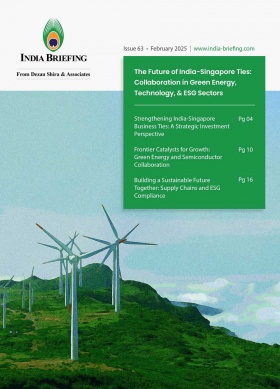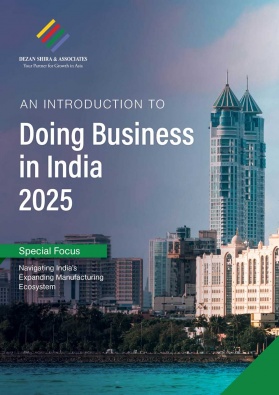India’s Private Sector CAPEX Hits Record High in FY 2024-25: MoSPI Report
India’s first report on private sector CAPEX trends shows a 66 percent surge in private firm investments in FY 2024–25 compared to FY 2021–22. Although spending is expected to dip in FY 2025–26, it is still projected to surpass pre-2023 levels, reflecting sustained progress in infrastructure growth and business development.
India’s Ministry of Statistics and Programme Implementation (MoSPI) has released a report titled the “Forward-Looking Survey on Private Sector CAPEX Investment Intentions.” Released on April 29, 2025, the report indicates that private sector capital expenditure (CAPEX) likely reached its peak in the financial year 2024–25, with investments rising by 66 percent to INR 6.56 trillion (US$77.54 billion) from FY 2021–22 figures of US$46.69 billion.
Although private CAPEX is projected to decline to INR 4.89 trillion (US$57.8 billion) in FY 2025-26, it is still expected to exceed the levels recorded during FY 2021-22 and FY 2022-23.
Survey insights on India’s CAPEX trends over five years
A consistent panel of 2,172 enterprises submitted complete data, forming the basis for India’s CAPEX trend analysis. This initial survey was conducted between November 2024 and January 2025, aiming to analyze capital expenditure patterns in the private corporate sector over five financial years. The aggregated (unweighted) CAPEX figures for this fixed panel are as follows:
|
Financial year |
CAPEX (INR trillion) |
Type of estimate |
|
FY 2021–22 |
3.95 (US$46.69 billion) |
Actual CAPEX |
|
FY 2022–23 |
5.72 (US$67.6 billion) |
|
|
FY 2023–24 |
4.22 (US$49.88 billion) |
|
|
FY 2024–25 |
6.56 (US$77.54 billion) |
Intended CAPEX |
|
FY 2025–26 |
4.89 (US$57.8 billion) |
Source: Ministry of Statistics & Programme Implementation (MoSPI)
Out of 3,064 firms that responded, 2,172 disclosed their capital investment plans for FY 2025–26.
Amid ongoing global trade and economic uncertainty, the report presents a cautious outlook for private capital expenditure in FY 2025–26. The MoSPI has recommended interpreting these projections with care, as the survey responses reflect a noticeable degree of conservatism. Nevertheless, the fixed sample of enterprises still indicates a 23.9 percent increase in unweighted capital expenditure over the period from FY 2021–22 to FY 2025–26.
Capital expenditure, or CAPEX, refers to the funds used by businesses to acquire or upgrade physical assets such as property, industrial buildings, or equipment—investments essential for long-term growth and productivity. CAPEX plays a vital role in expanding production capacity, which fuels economic growth, supports job creation, and boosts labour productivity. For a developing country like India, strong capex growth is essential for progressing toward its vision of becoming a prosperous and developed economy.
CAPEX growth in fixed assets
India’s private companies have been steadily increasing their fixed assets over recent years. In FY 2021-22, the average value of fixed assets per company was INR 31.51 billion (US$372.2 million). The figures grew to INR 32.79 billion (US$387.3 million) in FY 2022-23 and then jumped significantly to INR 41.83 billion (US$494 million) in FY 2023-24.
The industries with the highest fixed assets were those providing electricity, gas, steam, and air conditioning—where the average value per company crossed INR 140 billion (US$1.65 billion). Manufacturing came next, with companies holding assets worth between INR 70 billion (US$826.9 million) and INR 100 billion (US$1.18 billion) on average. Over the past three years, manufacturing firms held more than 65 percent of all fixed assets in the private sector, followed by utility companies at 8 percent to 10 percent.
Private companies CAPEX: Actual vs. planned
Private firms have generally matched or exceeded their planned investment levels in India since 2021. In FY 2021–22, actual capital expenditure per company was INR 1.09 billion (US$12.87 million), slightly higher than the intended INR 1.02 billion (US$12.05 million). A similar pattern followed in FY 2022–23, with actual spending at INR 1.48 billion (US$17.48 million) versus a planned INR 1.33 billion (US$15.7 million). In FY 2023–24, actual CAPEX per company (INR 1.07 billion/US$12.64 million) aligned with the proposed figure of INR 1.07 billion (US$12.64 million).
India’s CAPEX outcomes in FY 2024–25
For FY 2024–25, the average capital expenditure per enterprise for acquiring new assets is projected at INR 1.72 billion (US$20.31 million). A majority of the amount is expected to be invested in machinery and equipment, which accounts for 53.1 percent of the total. Capital work in progress is allocated 22 percent, while 9.7 percent will go toward the acquisition of buildings and other structures.
READ: India Manufacturing Tracker: 2024-25
|
Distribution of intended capital expenditure in FY 2024-25 by asset group |
|
|
Machinery and equipment |
53.1% |
|
Capital work in progress |
22% |
|
Dwellings, other buildings, and structures |
9.7% |
|
Other tangible assets/intellectual property products |
6.2%* |
|
Others |
9%* |
Source: Private Corporate Sector CAPEX, MoSPI
*The percent distribution is based on rough estimation.
Private sector investments strategy in FY 2024-25
Companies are employing a range of CAPEX strategies in FY 2024–25. Around 40.3 percent of firms are investing in the expansion of core assets, while 28.4 percent are focused on enhancing existing ones. Opportunistic investments are planned by 11.5 percent of enterprises, and 2.7 percent are pursuing debt-related strategies.
A small segment—less than 0.5 percent—is focusing on acquiring distressed assets or non-performing loans. The remaining 16.9 percent of enterprises employ a mix of diverse or alternative investment strategies.
When it comes to the underlying objectives of these capital investments, the majority—49.6 percent—are targeting income generation. About 30.1 percent of firms are channeling their investments toward upgrading current assets. Diversification is the primary aim for 2.8 percent of enterprises, while the remaining 17.5 percent have cited other unspecified goals for their capital expenditure.
Key takeaways
While India’s private CAPEX is projected to dip for FY 2025–26, investment levels are still expected to exceed those of earlier years, signaling continued momentum.
The survey inputs highlight notable year-to-year volatility in private CAPEX in the country, driven by shifting market conditions and conservative business outlooks amid global economic uncertainty. Despite cautious projections for FY 2025–26, cumulative CAPEX over the five-year period reflects a 23.9 percent rise.
Fixed asset investments have been on a steady incline, especially in utilities and manufacturing sectors, with machinery and equipment remaining the dominant asset class. Investment strategies vary, with the majority of firms focused on core asset expansion and income generation. This initiative marks a critical step toward better tracking and understanding private sector investment trends to support India’s long-term economic goals.
(US$1 = INR 84.59)
About Us
India Briefing is one of five regional publications under the Asia Briefing brand. It is supported by Dezan Shira & Associates, a pan-Asia, multi-disciplinary professional services firm that assists foreign investors throughout Asia, including through offices in Delhi, Mumbai, and Bengaluru in India. Dezan Shira & Associates also maintains offices or has alliance partners assisting foreign investors in China, Hong Kong SAR, Vietnam, Indonesia, Singapore, Malaysia, Mongolia, Dubai (UAE), Japan, South Korea, Nepal, The Philippines, Sri Lanka, Thailand, Italy, Germany, Bangladesh, Australia, United States, and United Kingdom and Ireland.
For a complimentary subscription to India Briefing’s content products, please click here. For support with establishing a business in India or for assistance in analyzing and entering markets, please contact the firm at india@dezshira.com or visit our website at www.dezshira.com.
- Previous Article India–Canada Ties Poised for Reset After Mark Carney’s Election Win
- Next Article Tamil Nadu Unveils India’s First State-Level Electronics Scheme







